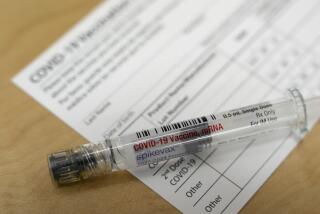Short on shots
- Share via
As the first doses of swine flu vaccine were made available this month, it looked as though the public might be scared away from inoculations by the chatter of such disparate anti-vacciners as Bill Maher and Rush Limbaugh. Now, of course, the opposite has happened: People are lining up at clinics and pestering their doctors for the vaccine, which is 12 million doses short of recent predictions. The country has about a fifth of what’s needed to inoculate its most vulnerable populations.
With the swine flu spreading so quickly that it has been declared a national emergency, we can only be grateful that so far, the H1N1 virus has not mutated into something more deadly. Though the federal government moved with admirable haste in the spring to research and produce a vaccine, lack of foresight in the early years of this decade is now leaving the country short.
It’s not like we weren’t warned. There have been repeated problems over the years with flu vaccine supply. Pharmaceutical companies have at times produced more than they could sell and then, stung by the experience, produced too little. The manufacture of vaccines can take six months or more using the traditional method of cultivating the virus in chicken eggs, then extracting, killing and purifying it. In 2004, the U.S. supply of flu vaccine was cut in half after a single manufacturing facility in Britain was closed down because of contamination.
As it turned out, the swine flu virus grew particularly slowly in the eggs, and the yield was lower than expected. That led a vaccine supplier in Australia to give first priority to that country, worsening the scenario in the United States. Only one of the five suppliers under contract to the U.S. does all of its manufacturing here.
A more promising process derives vaccine by culturing the virus in mammal cells rather than eggs, cutting production time by half. But because of earlier funding delays by Congress, the technology is inches beyond our reach during this pandemic. Under a joint venture with the federal government, Novartis will cut the ribbon in November on a South Carolina plant that is expected to produce cell-based vaccine within a couple of years. This and similar grants awarded by the Department of Health and Human Services in 2005 and 2006 will quicken production and provide badly needed manufacturing capacity within the United States.
The swine flu isn’t giving us a couple more years, though, and the promised eventual rollout of traditionally produced vaccine is far from reassuring. The swine flu season got an early start, and the millions of people who cannot get inoculations will have to rely on even older flu fighters: covering sneezes and washing their hands.






